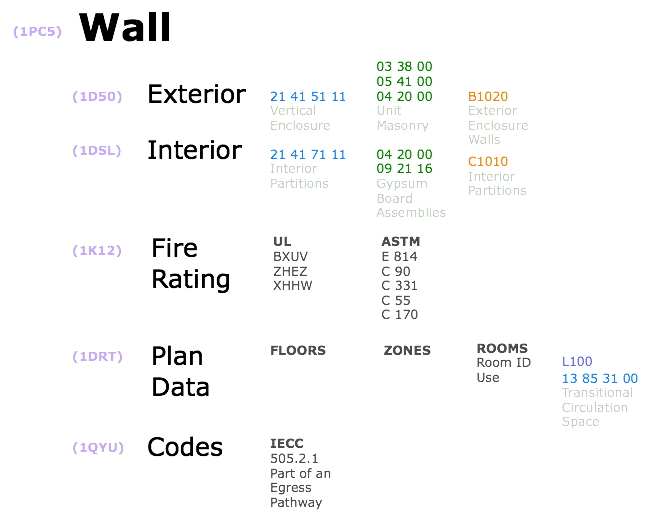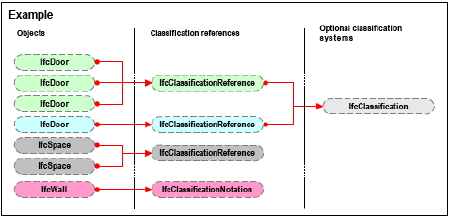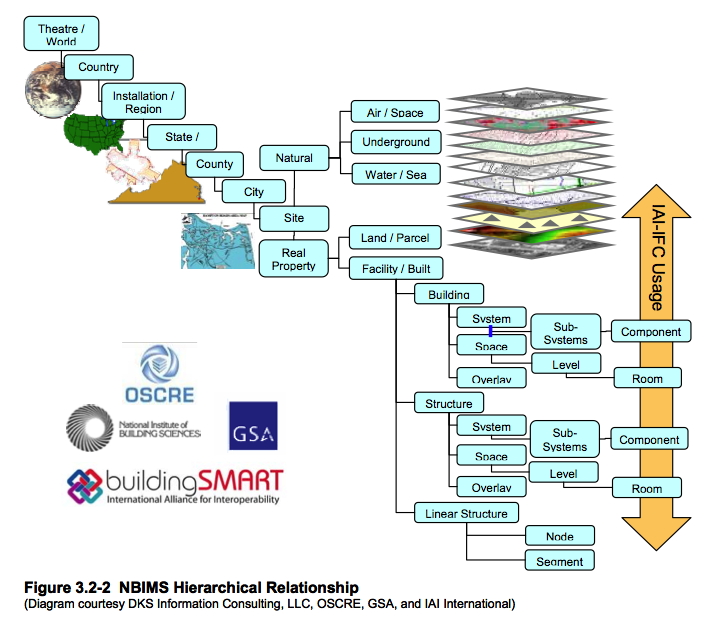Content (1RYL)
The content is limited to terms relevant to the OpenFloorplanDisplay and FloorplanDataExchange Projects and the Fire Code including basic structure, room information, fire safety features, emergency response and open standards terminology. (1SRY)
- Subsequent work will extend to Building Codes, high performance building features, sustainable design, and environmental issues. (1SB9)
- Until that time, this dictionary is limited to information relevant to Next Generation 9-1-1, building owners, fire department inspectors, and useful for police. (1SNH)
Organized in Themes Below (1S45)
- Themes have not been consolidated yet, terms are not in any particular order (1SHD)
- Acronym and explanation are the minimum, where possible links are added (1SBG)
- Considering combining the Acronyms and Glossary elements into a Taxo-Thesaurus (1SBH)
- Fire Department Terms (1RW8)
- Static 2D Terms (1S47)
- Dynamic Overlay Terms (1RWA)
- Fire Code Terms (1S48)
- NG9-1-1 Terms (1RWC)
- Open Standard Terms (1SBA)
- OGC NBIMS Diagram Terms (1S4A)
Idealized Screen Shot of the Completed Dictionary (1SWT)
From Building Lifecycle Interoperable Software (BLIS) IFC 2x Object Diagram - Classification (1RPU)
Part of a drawing by VTT Building Technology, Author: Jiri Hietanen, Copyright 2000 (1RSR)
Fire Department Terms (1S4B)
From OSHA 3256-07N Glossary of Acronyms and Terms. Additional Comments from: Stephen J. Wisely, Interim Director, Communication Center and 9-1-1 Services Department, APCO International Headquarters, Keith H. Johnson, Battalion Chief, Fairfax County Fire & Rescue Department, Fire Prevention Division (1SHE)
- Authority Having Jurisdiction (AHJ) : The entity legally designated to enforce a code or standard. (1S4D)
- An organization, office or individual responsible for enforcing the requirements of a code or standard, or for approving equipment, materials, or installation, or a procedure. (1S4E)
- Apparatus: Fire service vehicle. (1SBB)
- (1SBC)
- A vehicle designed to be used under emergency conditions to transport personnel and equipment, and to support the suppression of fires and mitigation of other hazardous situations. (1SBD)
- Aerial (1S4I)
- Apparatus that carries ladders and tools (1S4J)
- Apparatus that is equipped with as aerial ladder of aerial tower and carries ladders and misc tools. (1S4K)
- A vehicle equipped with an aerial ladder, elevating platform, or water tower that is designed and equipped to support fire fighting and rescue operations by positioning personnel, handling materials, providing continuous egress, or discharging water at positions elevated from the ground. (1S4L)
- Command and Communications (1S4M)
- A fire apparatus used primarily for communications and incident command. (1S4N)
- Hazardous Material Response (1S4O)
- An emergency vehicle designed to carry various support equipment and personnel to a scene of a hazardous material incident. (1S4P)
- Initial Attack (1S4Q)
- Fire apparatus with a fire pump of at least 250 gpm (1000 L/min) capacity, water tank, and hose body whose primary purpose is to initiate a fire suppression attack on structural, vehicular, or vegetation fires, and to support associated fire department operations. (1S4R)
- Mobile Foam Fire (1S4S)
- Fire apparatus with a permanently mounted fire pump, foam proportioning system, and foam concentrate tank(s) whose primary purpose is for use in the control and extinguishment of flammable and combustible liquid fires in storage tanks and other flammable liquid spills. (1S4T)
- Mobile Water Supply (Tanker, Tender) (1S4U)
- A vehicle designed primarily for transporting (pickup, transporting, and delivering) water to fire emergency scenes to be applied by other vehicles or pumping equipment. (1RQ5)
- Pumper (1S4V)
- Quint (1S4Y)
- Apparatus that contains aerial and pumper equipment (1S4Z)
- Apparatus that is equipped with and aerial ladder or tower, a pump and a water tank along with misc equipment. (1S50)
- Fire apparatus with a permanently mounted fire pump, a water tank, a hose storage area, an aerial ladder or elevating platform with a permanently mounted waterway, and a complement of ground ladders. (1S51)
- Rescue (1S52)
- Apparatus equipped with necessary tools to effect rescue in structures and at special operations (1S53)
- (1SBC)
- Code Official: A fire code official, building code official, or authority having jurisdiction. (1S54)
- Elevating Platform: A self-supporting, turntable-mounted device consisting of a personnel-carrying platform attached to the uppermost boom of a series of power-operated booms that articulate, telescope, or both and that are sometimes arranged to provide the continuous egress capabilities of an aerial ladder. (1S5B)
- Engine Company: Pumper apparatus and personnel. (1S5C)
- First Due Unit: Engine company or truck company designated to respond first to an incident at a given location. (1S5D)
- Engine company or truck (ladder) company designated to normally arrive first to an incident at a given location. (1S5E)
- Hose Lay: (1S5F)
- Straight or Forward: An engine company evolution (task) to lay hose from a water source to an incident scene or another unit (1S5G)
- Reverse: An engine company evolution (task) to lay hose from an incident scene or another unit to a water source (1S5H)
- Preconnected: A hose of fixed length with a nozzle attached and connected to a discharge outlet on a pumper (1S5I)
- Preconnected Hose Line: A hose line that is stored on the apparatus already connected to an outlet on a pump and that can be charged by the activation of one discharge valve. (1S5J)
- IBC: International Building Code. (1S5K)
- IFC (1S5L)
- Ladder Company: Aerial apparatus and personnel. (1S5O)
- Apparatus equipped with an aerial ladder or tower, ladders, misc equipment and personnel. (1S5P)
- Rescue Company : Apparatus equipped qith misc. tools and possibly ladders to effect rescue and staff with appropriate personnel. (1S5Q)
Add text (1V4T)
- Rescue Engine : Apparatus which is a combination of an engine (pumper) and a rescue company. (1S5R)
- Incident Commander (IC) (1S5S)
- NFPA: National Fire Protection Association (1S60)
- Pre-incident Plan: Document or information model containing information on a specific facility to facilitate emergency operations. (1SNM)
- Truck Company: Aerial apparatus and personnel. (1S67)
For Static vs Dynamic Data and NG9-1-1 Terms Below: Refer to table Architecture, Elements, Alerts and Table 1 Building Source Data Classification for Emergency Response Purposes (RT = real time) in Emergency Response Scenario.pdf Building Emergency Response Scenario by Alan Vinh at NIST Building Fire Research Lab. (1SHH)
Static Data (1S69)
- Building Information (1SS0)
- Address (1SS1)
- Compass directions and Building side labels (A,B,C,D) (1SS2)
- Occupant Information (1SSD)
- Contact Information (1R7N)
- Building Owner (1SSF)
- Facility Manager (1SSG)
- Building Engineer (1SSH)
- HVAC Contact (1SSI)
- Gas Company Contact (1SSJ)
- Power Company Contact (1SSK)
- Water Department Emergency Contact (1SSL)
- State Hazardous Materials Duty Officer (1R7V)
- Central Service Agency (CSA) contact (1SNN)
- Room Phone Numbers: Assigned to the wall jacks in each room, only tracked if the owner/operator chooses to do so. Room phone numbers relate to where a 911 calls might originate from. (1SSM)
- Background (Architecture) (1SSN)
- Envelope (1SSO)
- Plans of all floors from basement up to and including roof. (1SSP)
- Room / Tenant numbers and graphic directories of tenant / agency layout. (1SSQ)
- When a building has multiple entrances on different levels, the fire department needs to coordinate the elevator recall floor to see if the elevators are empty or use in their operations need to agree on what is the main floor designated in the Open Floor Plan Display project as Floor 0 (1SSR)
- Label Shafts that are not obviously elevators (1SSS)
- Walls and Partitions (1SST)
- Doors (1SSX)
- Location (1SSY)
- Firefighter Entrances (1SSZ)
- Construction (1ST0)
- Normally open / closed / locked status (1ST1)
- Label rear entry doors with tenants name and address or suite number (1ST2)
- Label service doors Electric Room or Sprinkler Room (1ST3)
- Any door that appears to be functional outside but is unusable for any reason should be labeled THIS DOOR IS BLOCKED (1ST4)
- Windows (1ST5)
- Stairs (1ST9)
- Elevators (1STG)
- Exits (1STK)
- Fixed Display (1STL)
- Special Features (1STM)
- Space (Room) Information (1STZ)
- Safety Elements (1SUJ)
- Fire Command Center (1SUK)
- Water Supply (1SUN)
- Fire Pumps (1SUO)
- Standpipe Outlets (1SUP)
- Type of system (1SUQ)
- Identification number (1SUR)
- Area covered (vertical drop and horizontal run) (1SUS)
- Mark when remote from fire department access (1SUT)
- Mark systems with a demand over 150psi (1SUU)
- More floor plan labels and physical building signs are required for underground areas (1SUV)
- Mark partial systems (1SUW)
- Mark sections of non-interconnected systems (1SUX)
- Sprinklers (1SUY)
- Connections - optionally areas served by each connection (1SV2)
- Equipment (1SV7)
- Areas of refuge (1R8C)
- Sensors (1SVA)
- Cameras (1SVB)
- Utility Shutoffs (1SVC)
- Building features also useful to police (1RJI)
- Site Features (1R8O)
Dynamic Data to Overlay on Static Floorplans (1S6A)
- Spatial / Temporal (Incident Specific) (1SVJ)
- First Responder Status (1R9A)
- Elevator Status (1SVX)
- Fire Decision Support (1R9N)
- Security Information (1RA1)
- Control Functions (SB 30 section 5.3) (1RA7)
- Event Closeout (1RAC)
Fire Code Terms (1S6B)
Fire Command Center : 2006 International Fire Code, Section 509 (1SW6)
- The fire command center shall comply with NFPA 72 and contain the following features: (1SW7)
- The emergency voice / alarm communication system unit. (1SW8)
- The fire department communications system. (1SW9)
- Fire-detection and alarm system annunciator system. (1SWA)
- Annunciator visually indicating the location of the elevators and whether they are operational. (1SWB)
- Status indicators and controls for air-handling systems. (1SWC)
- The fire-fighter's control panel required by Section 909.16 for smoke control systems installed in the building. (1SWD)
- Controls for unlocking stairway doors simultaneously. (1SWE)
- Sprinkler valve and water-flow detector display panels. (1SWF)
- Emergency and standby power status indicators. (1SWG)
- A telephone for fire department use with controlled access to the public telephone system. (1SWH)
- Fire pump status indicators. (1SWI)
- Schematic building plans indicating the typical floor plan and detailing the building core, means of egress, fire protection systems, fire-fighting equipment and fire department access. This is the work of the Open Floor Plan Display project (1SWJ)
- Work table. (1SWK)
- Generator supervision devices, manual start and transfer features. (1SWL)
- Public address system, where specifically required by other sections of this code. (1SWM)
Fire Department Access to Equipment : 2006 International Fire Code, Section 510, 510.1 Identification (1SWN)
- Fire protection equipment shall be identified in an approved manner. (1SWO)
- Rooms containing controls for air-conditioning systems, sprinkler risers and valves, or other fire detection, suppression or control elements shall be identified for use by the fire department. (1SWP)
- Approved signs required to identify fire protection equipment and equipment location, shall be constructed of durable materials, permanently installed and readily visible. (1SWQ)
Building Address (1RS2)
- Addresses on each building of a complex (1SOG)
- If the building faces more than one street, provide street name with address number for entrances facing other streets (1ROV)
- Numbers should be numbers not spelled out 120 not One Hundred Twenty (1SOH)
- Buildings set back in groups sharing a common entrance need additional signs with direction arrows or diagrams (1ROX)
- When possible, address signs should be illuminated (1ROY)
- North direction arrow (1ROZ)
NG9-1-1 Terms (1S6C)
- 9-1-1 (1S6D)
- 9-1-1 incident report (1S6E)
- Access the Building BBS (1S6F)
- Alarm Classifications (1SWR)
- Alert (1S6G)
- Best path to attack the fire (1S6K)
- BISACS: Building Information Services and Control System (1SHI)
- BISACS Base Server (BBS) (1SOL)
- Bound to location information (1S6M)
- Building (1S6N)
- Data (1S6R)
- Cell Tower Triangulation (1S6V)
- Central Station Alarm (CSA) Company (1SOM)
- Commercial Building (1S6X)
- Communicate the Fire Situation (1S6Z)
- Control Functions (1S70)
- Computer Aided Dispatch (CAD) (1SON)
- Disambiguation: Computer Aided Design ('CAD') (1SOO)
- Conditions (1S73)
- Decision Support (1S76)
- Deduced from a floorplan (1S77)
- Direct incident area wireless network connection (1S78)
- Disables (1S79)
- Dispatcher (1S7A)
- Enroute response (1S7C)
- Flashing Icon (1S7E)
- GPS: Global Positioning System (1SHN)
- GPS Receiver (1SHO)
- High Bandwidth (1S7G)
- High Temperature Alert (1S7H)
- Incident Assessment (size-up) (1S7J)
- Independent Calls (1S7K)
- Initial Dispatch (1S7L)
- Internally Authorize (1S7M)
- Jurisdictions Standard Fire Response (1S7N)
- Location Information (1S7O)
- Mobile Data Computer (MDC) (1SOP)
- Most Recent Version (1S7Q)
- Movement of the Fire (1S7R)
- Navigation (1S7S)
- NG9-1-1: Next Generation 9-1-1 (1S7T)
- Orient to the Streets (1S7U)
- Pre-Plan (1S7V)
- Pre-Loaded Building Pre-Plan (1SHP)
- Procedures (1S7X)
- Public Safety Answering Point (PSAP) (1SOQ)
- Public Safety Representative (1S7Z)
- Radio System Data Channel (1S80)
- Real-Time (1S81)
- Related Alerts (1S84)
- Renovation (1S85)
- Responding Units (1S86)
- Route to Responders (1S8E)
- Scenario (1S8F)
- Security Information (1S8G)
- Sensors (1S8K)
- Smoke alarm (1S8L)
- Software (1S8M)
- Status of Sprinkler Systems (1S8Q)
- Text Message (1S8R)
- Transmit (1S8S)
- Trouble Condition (1S8T)
- Useful (1S8U)
- Verify Alert (1S8V)
- Water Requirements (1S8W)
Open Standards Terms (1S8X)
- AJAX: Asynchronous JavaScript and XML - used to enable web servers (1SWS)
- ASHRAE: American Society of Heating, Refrigerating and Air-Conditioning Engineers ASHRAE (1SBO)
- BACNET: Building Automation and Control Networks (1SBY)
- BIEFR: Building Information Exchange with First Responders (1SBI)
- BIM: Building Information Modeling (1SA6)
- CAP: Common Alerting Protocol (1SAB)
- CGI: Common Gateway Interface (1SBP)
- EDXL: Emergency Data Exchange Language EDXL (1SBU)
- EDXL-DE: Distribution Element (1SAE)
- EDXL ValueListURN (1SBJ)
- EDXL-RIM: Reference Information Model (1SBK)
- EDXL-DE: Distribution Element (1SAE)
- GGSN: Golden Gate Safety Network (1SAF)
- MVD: Model View Definition, a standard framework for NBIMS (1SAJ)
- NBIMS: National Building Information Modeling Standard (1SAK)
- NIST BFRL: National Institute of Standards and Technology Building Fire Research Lab (1SAL)
- OASIS: Organization for the Advancement of Structured Information Standards (1SAM)
- OSHA: Occupational Safety and Health Administration, (1SHT)
- QA: Quality Assurance (in documents before) (1SAR)
- QC: Quality Control (during construction or installation) (1SAS)
- QA/QC: A Quality Assurance / Quality Control Program (1SAT)
- SB30 Identity Information Protection Act (1SAU)
- SVG (1SAV)
- UniFormat (UF) (1SOX)
- A collaboration between GSA, RSMeans, CSI and others - used for systems and assemblies (1SOY)
- URL: Uniform Resource Locator (1SBW)
OGC NBIMS Diagram (1S8Z)
Reference: OGC Glossary of Terms (1SP4)
- Theatre / World (1S91)
- Disambiguation Theater (1SOZ)
- Country (1S93)
- Installation / Region (1S94)
- State (1S95)
- County (1S96)
- City (1S97)
- Natural (1S98)
- Site (1S9C)
- Real Property (1S9D)
- Land / Parcel (1S9E)
- Facility / Built (1S9F)
- Building (1S9G)
- Structure (1S9H)
- Linear Structure (1S9P)
- IAI-IFC Usage: International Alliance for Interoperability (now building SMART international) - Industry Foundation Classes (1S9T)
Problems - Need to work definitions into consolidated dictionary (1SHU)
- Counterflow - fire fighters need to go up stairs while occupants are exiting, stairs should be wider on lower levels or at confluence points. (1SP1)
- Follow building signage requirements in stairs to label stair entry and exit floors in static floor plans the same as they should be labeled in the physical building. (1SP2)
- Storage or Use of Flammable or Combustible Materials (1S9W)
- Structures susceptible to early collapse (1S9X)
- Hazardous openings (1S9Y)
- Heavy Items (1S9Z)
- Potential Traps such as swimming pools (1SA0)
Cautionary Notes on the Development of the Glossary, Dictionary, Thesaurus (1RS0)
From RexBrooks: A case in point for one of the provisions we have built into the Emergency Data Exchange Language (EDXL) set of specifications in the Organization for the Advancement of Structured Information Standards (OASIS) Emergency Management Technical Committee (EM TC). (1RJW)
- The EM TC discovered when writing the EDXL Distribution Element (EDXL-DE) v1.0 Specification, different organizations, governmental jurisdictions and Non-Governmental Organizations (NGOs) often have different terms for the same object, piece of equipment, or organizational role or position; such as an "Engine X0", "Engine Unit" OR "Apparatus (see below)" and we could not settle on any single master vocabulary or terminology. So we developed the "Keyword"-"ValueListURN"-"Value" system to handle such lists of terms and values. A Keyword identifies the list and the ValueListURN provides the means to cite and access it. In practice, it is always best to keep a local copy of the ValueList which local applications can validate against (in XML terms). (1RJX)
- One of the provisions I would like to see is the adoption or adaptation of a Keyword / ValueListURN type of flexibility where there may be multiple lists of terms and values that could apply to the same or fundamentally identical objects, names, roles, etc. (1RJY)
Dictionary initiated and maintained by DeborahMacPherson (1RYK)


